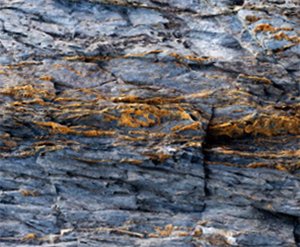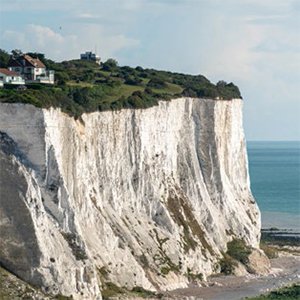
Crystal Clear Confirmation of a Young Earth
Geology
Can the size of a crystal further confirm the timescale in God’s Word?
According to evolutionists, when you wipe the sandwich crumbs off your granite countertops, you’re swiping your hand over what they tell us takes up to a million years to form. But in results from a recent study, those large crystals that glisten in your granite countertop have scientists facing the flaws in their evolutionary assumptions about how long it takes for granite to form, cool, and crystallize.
Crystal size is usually linked to how fast or slowly magma (molten rock) cools. Lavas erupt from volcanoes and cool rapidly—within minutes to days—to form basalts, which consist of minute crystals mostly only visible under a microscope. In contrast, evolutionary scientists believe that magma that cools and crystallizes deep underground cools more slowly, over 100,000 to 1 million years, to form granite (and other rocks) with visible crystals typically up to half an inch or so (a centimeter or more) long. Of course, scientists have never actually observed this process.
But in an October 2020 study published in Nature Communications, Rice University, Houston, graduate student Patrick Phelps and geology professor Cin-Ty Lee reported their research results that demonstrate large crystals, including crystals that are gemstones, grow in granite within minutes to hours! Though it shocked these researchers, biblical creationists see this study as further confirmation of the biblical timescale which puts the earth’s creation only about 6,000 years ago and the global flood, when many granites formed, just over 4,300 years ago.
A Pegmatite Puzzle
Large crystals and gemstones frequently grow in pegmatites, which are relatively small, thick, and long vein-like bodies that often form associated with granites. A lot of water is dissolved under pressure in the magma from which granite forms. As the magma cools, the feldspar and quartz that crystallize to form granite do not soak up that water, nor most of the rare elements such as lithium (Li) and germanium (Ge). The leftover magma becomes increasingly concentrated with water and rare elements, making the magma very fluid and easily squeezed into cracks in the surrounding rocks which are then forced open by pressure. In the cracks, the leftover watery magma crystallizes and cools very rapidly to produce the pegmatite.
But here’s the puzzle. Pegmatites often contain some of the largest known crystals. The study focused on crystals in the Stewart pegmatite of the Pala district just north of San Diego, Southern California. This pegmatite, which is up to 164 feet (50 meters) wide, is mined for its quality tourmaline gemstones and valuable element minerals such as spodumene (a major source of lithium for cell phone batteries) in large crystals up to 4 inches (10 centimeters) long and even longer. But those don’t come close to the largest known crystals. For example, the Etta pegmatite associated with the Harney Peak Granite of Mount Rushmore near Rapid City, South Dakota, holds a world record for the largest single crystal, a spodumene crystal 42 feet (almost 13 meters) long and an estimated 37 tons (33.5 tonnes).
So how could such large crystals grow from a rapidly crystallizing, short-lived watery magma?
How Crystals Grow
In the Stewart pegmatite, Phelps and Lee closely examined several large zoned crystals of quartz (SiO2 or silica, the same as window glass), including one measuring half an inch (12 mm) wide by over 1 inch (25 mm) long. These crystals came from chimney-like cavities branching upward from the very coarse-grained core zone of the pegmatite body where some of the largest exotic crystals are located.
Using a laser beam instrument, they analyzed the trace elements across different zones in the crystals, confirming that the zones formed because of varying concentrations of these trace elements.
To determine the crystal growth rates, they considered two key variables: the likelihood of the trace elements being brought into the crystals from the host fluids, and how quickly each of these trace elements is brought into the crystals.
The other key aspects contributing to the crystal growth rates would be the high concentrations of trace elements in the watery leftover magma, plus the rapid turbulent flow of this watery magma into this pegmatite’s chimney-like cavities. In the watery mixture, these leftover elements can move around much faster, and their diffusion rates are faster in such fluids, which tend to flow more quickly. So when crystals start forming, elements can get to them sooner, which means they can grow more rapidly.
With these principles, the investigators modeled the possible growth rates of these crystals based on the concentrations of trace elements in the leftover watery magma from which these crystals grew. They then compared their models to their actual measurements of the trace element concentrations in the crystal zones.
Rethinking Millions of Years
Using this known chemistry and physics as well as sound math, these scientists discovered that crystal cores had grown 0.4–4 inches (10–100 mm) per day, and the outer zones had grown 3–33 feet (1–10 meters) per day. They concluded that the cores in the quartz crystals they investigated would have grown in fewer than three hours, and the outer zones in less than four minutes. Furthermore, the largest crystals found in pegmatites would have grown in just days, and smaller gemstones such as tourmaline and emerald would also have grown in hours.
Phelps said, “I remember . . . saying, ‘Is this feasible? I don’t think this is right. Because in my head I was still kind of thinking about a thousand-year time scale. And these numbers were meaning days or hours.’”1
Such rapid growth rates of these pegmatite crystals may seem outrageous and extraordinary to these scientists with a slow-and-gradual mindset.
Such rapid growth rates of these pegmatite crystals may seem outrageous and extraordinary to these scientists with a slow-and-gradual mindset. However, independent studies have already demonstrated that similar rapid growth rates produced some large crystals in certain granites and some volcanic rocks. So the growth of large crystals in as little as minutes is well-demonstrated and well-known from experiments, whereas this study is significant for determining such fast growth rates for naturally grown crystals.
Can these results also be applied to the growth of all the crystals in granites, thus necessitating the granites themselves formed within days? Yes, this same research strategy should now be used on crystals in granites because there is much other evidence to demonstrate granites, and their crystals, could have formed within days.2
Indeed, evolutionists are willingly ignorant of and suppress so much evidence around the globe for the Genesis flood cataclysm (see below). After all, its catastrophic watery conditions were unlike anything scientists have ever witnessed.
Careful scientific research continues to confirm what God’s inerrant Word teaches about the true history of the earth. Even when wiping the crumbs off our countertop, we can remember that God never lies (Titus 1:2), and we can trust his written Word, the Bible, as our absolute authority in everything.
Not So Slow After All
More Examples of Rapid Geological Processes

Mudrocks make up the majority of the geologic record, such as the 900-feet (275 meters)-thick Marcellus Shale of Ohio, Pennsylvania, and New York. We used to think mud layers formed slowly as tiny mud particles settled in standing water. Now we know from impeccable experiments and investigations that many layers form instantly at the same time from water flowing horizontally, under “high-energy” conditions, such as those during the Genesis flood.

Chalk (a type of limestone), such as the 1,000-feet (305 meters)-thick layers exposed as white cliffs along the English coast, consists of tiny lime particles supposedly deposited on the ancient ocean floor a fraction of an inch (several millimeters) per thousand years. However, on the continents, the chalk layers buried and fossilized huge fish, dinosaurs, and birds, a testimony to rapid chalk formation as the ocean waters flooded the continents.

Fossilization requires instant catastrophic rapid burial of creatures and plants before they are eaten by scavengers or simply rot away. Many fossils are preserved with incredible details, sometimes even with soft tissues still intact. Numerous examples are available of fish with undigested fish in their mouths or stomachs, ichthyosaurs giving birth to live young, dinosaur bones with blood vessels and even blood clots, and squid with ink still in their sacs.

Precious opals, found primarily in Australia’s outback, consist of silica that crystallized from solutions in groundwaters under unique conditions that fit into the flood year. Laboratory experiments have duplicated how they form quickly within days, not requiring millions of years. Note that the petrification process to turn buried creatures into fossils often involves silica deposited from groundwaters via the same rapid process.

Canyon Erosion. The 1980–1982 volcanic eruptions at Mount St. Helens provided many geological lessons in a natural laboratory. On March 19 and May 19, 1982, eruptions caused mud and melted snow debris flows to carve canyon systems within hours up to hundreds of feet deep, some through solid rock. The canyons, carved within hours, look the same as those elsewhere, such as the Grand Canyon which evolutionists claim took millions of years to be carved.

Coral Reefs are massive accumulations of billons of corals, sometimes thousands of feet thick and tens to hundreds of miles long. Corals seemingly grow slowly today, so it would supposedly take tens of thousands of years for today’s reefs to have grown. However, actually observed examples indicate that under the right conditions corals can grow up to 4–17 inches (10–43 centimeters) per year, with maximum reef growth rates somewhat less.
Answers Magazine
January–March 2021
Meet the team of artists and writers behind the world’s most pro-life museum exhibit.
Browse IssueFootnotes
- Jade Boyd, “Earth Grows Fine Gems in Minutes,” Rice University, October 6, 2020, http://news.rice.edu/2020/10/06/earth-grows-fine-gems-in-minutes-2/.
- Andrew A. Snelling, “Catastrophic Granite Formation: Rapid Melting of Source Rocks, and Rapid Magma Intrusion and Cooling.” Answers Research Journal 1 (2008): 11-26, https://answersingenesis.org/geology/catastrophism/catastrophic-granite-formation/.
Recommended Resources

Answers in Genesis is an apologetics ministry, dedicated to helping Christians defend their faith and proclaim the good news of Jesus Christ.
- Customer Service 800.778.3390
- Available Monday–Friday | 9 AM–5 PM ET
- © 2025 Answers in Genesis



